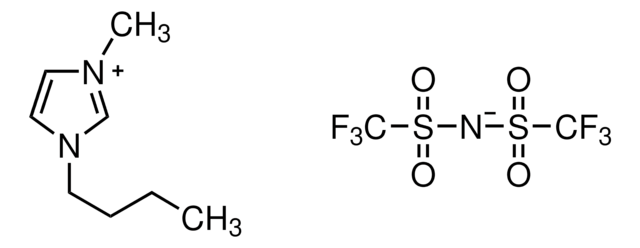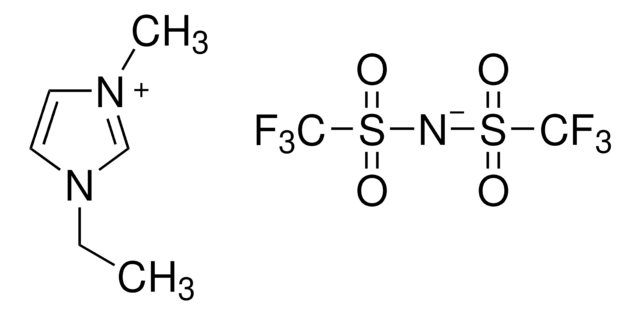Kluczowe dokumenty
900804
1-Butyl-2,3-dimethylimidazolium bis(trifluoromethylsulfonyl)imide
≥99%, H2O <500 ppm
Synonim(y):
1-Butyl-2,3-dimethylimidazolium bis(trifluoromethylsulfonyl)amide, 1-Butyl-2,3-dimethylimidazolium bistriflamide
About This Item
Polecane produkty
Poziom jakości
Próba
≥99%
Formularz
liquid
skład
H2O, <500 ppm
zanieczyszczenia
≤500 ppm H2O
bp
430 °C (decomp(lit.))
mp
-76 °C (lit.)
gęstość
1.4059 g/cm3
Zastosowanie
battery manufacturing
InChI
1S/C9H17N2.C2F6NO4S2/c1-4-5-6-11-8-7-10(3)9(11)2;3-1(4,5)14(10,11)9-15(12,13)2(6,7)8/h7-8H,4-6H2,1-3H3;/q+1;-1
Klucz InChI
UCCKRVYTJPMHRO-UHFFFAOYSA-N
Zastosowanie
produkt powiązany
Hasło ostrzegawcze
Danger
Zwroty wskazujące rodzaj zagrożenia
Zwroty wskazujące środki ostrożności
Klasyfikacja zagrożeń
Acute Tox. 3 Oral - Eye Dam. 1
Kod klasy składowania
6.1C - Combustible acute toxic Cat.3 / toxic compounds or compounds which causing chronic effects
Klasa zagrożenia wodnego (WGK)
WGK 3
Temperatura zapłonu (°F)
230.0 °F
Temperatura zapłonu (°C)
110 °C
Wybierz jedną z najnowszych wersji:
Certyfikaty analizy (CoA)
Nie widzisz odpowiedniej wersji?
Jeśli potrzebujesz konkretnej wersji, możesz wyszukać konkretny certyfikat według numeru partii lub serii.
Masz już ten produkt?
Dokumenty związane z niedawno zakupionymi produktami zostały zamieszczone w Bibliotece dokumentów.
Klienci oglądali również te produkty
Produkty
Dr. Sun reviews the recent advances in solid-state rechargeable batteries and cover the fundamentals of solid electrolytes in solid-state batteries, the theory of ion conduction, and the structures and electrochemical processes of solid-state Li batteries.
Półprzewodnikowe akumulatory Li: Przegląd elektrolitów stałych, przewodzenia jonów, struktur i procesów elektrochemicznych.
Here, we present a short review of ionic liquid electrolytes used in state-of-the-art rechargeable batteries including high performance and low-cost aluminum batteries, non-flammable Li-based batteries, and high-cycling and stable dual-graphite batteries. We also outline the key issues explored so as to identify the future direction of IL development.
Nasz zespół naukowców ma doświadczenie we wszystkich obszarach badań, w tym w naukach przyrodniczych, materiałoznawstwie, syntezie chemicznej, chromatografii, analityce i wielu innych dziedzinach.
Skontaktuj się z zespołem ds. pomocy technicznej







